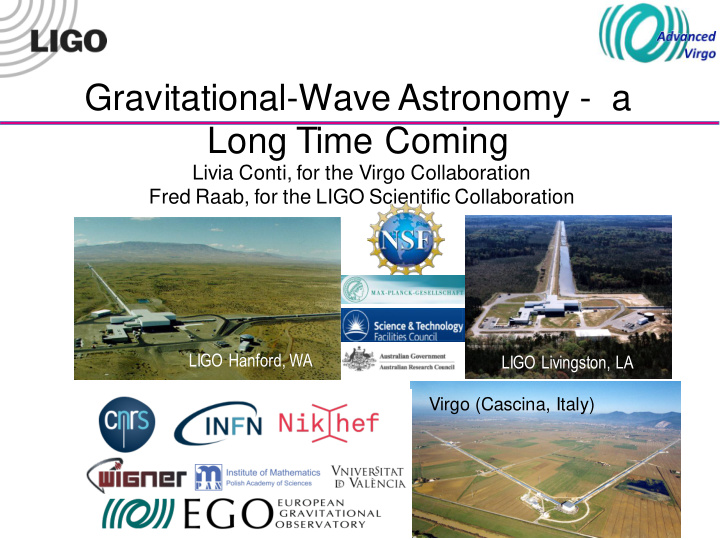



Gravitational-Wave Astronomy - a Long Time Coming Livia Conti, for the Virgo Collaboration Fred Raab, for the LIGO Scientific Collaboration LIGO Hanford, WA LIGO Livingston, LA Virgo (Cascina, Italy)
What are we talking about? Gravitational waves from merging black holes Gravitational waves and elecromagnetic waves from merging neutron stars Credits: NSF/LIGO/Sonoma State University/A. Simonnet
Basics of General Relativity and Gravitational Waves Big idea: space and time are things, whose properties are manifested by the phenomena that we collectively refer to as “gravity”.
Einstein’s General Relativity: gravity is a manifestation of space-time curvature dynamic deformation of curved spacetime can bend light, too! spacetime Credit: R. Hurt - Caltech / JPL: A massive object shifts apparent position of a star Space has a shape, a stiffness and a maximum speed for information transfer.
Raab - Intro to GW Astronomy 5 Credit: NASA
Detectors of Gravitational Waves No Law of Physics Forbids Them
Basic idea is simple: a GW causes a circle of space to go out of round GW amplitude h = deformation/size Isolated mirrors are survey stakes in space Light takes more (less) time to travel the longer (shorter) path
Interferometer as GW detector Equal arm length → destructive interference Unequal arm length → constructive interference
Noise cartoon R. Adhikari
History: the story of how problems became opportunities
Strategy: Build Facilities That Could House Evolving Generations of More Powerful Detectors as Part of an International Network • LIGO proposed in 1989. • Virgo proposed in 1989. • LIGO Observatories constructed • Virgo construction from 1996 to from 1994-2000. 2003. • LIGO establishes international • Virgo and LIGO establish a LIGO Scientific Collaboration (LSC) in 1997. common data format for GW observatories. • Initial LIGO operated from 2002- • Initial Virgo operated from 2007 to 2010. 2011. • Advanced LIGO construction 2008- • Advanced Virgo construction from 2015. 2011 to 2016. LSC and Virgo Collaboration established an MOU for joint operations in 2007.
The Laser Interferometer Gravitational-wave Observatory LHO LLO Livingston, LA
The Laser Interferometer Gravitational-wave Observatory LSC Institutions LHO LLO Livingston, LA
VIRGO A collaboration made up of 20 laboratories in 6 european countries, involving more than 280 physicists and engineers Cascina (Pisa), Italy
VIRGO A collaboration made up of 20 laboratories in 6 countries involving the following institutions: Cascina (Pisa), Italy
The advanced GW detector network: 2015-2025 Livingston, LA
First Direct Detection of Gravitational Waves Opening a New Window on the Universe
What can we learn from h(t)? Phase evolution gives chirp mass and aligned components of spin B. P. Abbott et al. (LIGO Scientific Collaboration and Virgo Collaboration), Phys. Rev. Lett. 116, 061102 (2016) Ringdown frequency and Q Modulation of amplitude give mass and spin Highest frequency gives gives nonaligned spin of final black hole sizes of objects just components before merger.
Multi-Messenger Astronomy These first observations of dynamic extreme spacetimes with BBHs show us that GR is reasonably accurate in this regime and can be used as a tool for examining and interpreting extreme states of matter. Raab - Intro to GW Astronomy 19
Onto the study of the most extreme states of matter – GW170817 Credit: NASA's Goddard Space Flight Center, Caltech/MIT/LIGO Lab and ESA Raab - Intro to GW Astronomy 20
LIGO-Virgo network localization enables discovery of optical counterpart Figure 1 from Multi-messenger Observations of a Binary Neutron Star Merger B. P. Abbott et al. 2017 ApJL 848 L12 doi:10.3847/2041-8213/aa91c9
The Future We now know that black hole binaries merge several times an hour somewhere in the universe; with new detectors and facilities, we should be able to see them out to the first generations of stars.
Concepts Under Study for Future Gravitational-Wave Observatories Artistics rendering of Einstein Telescope, rd the 3 generation european detector capable of observing compact binary sources with high signal-to- noise ratio throughout the Universe. Credit: Evan Hall
Personal reflections in summary There were dozens of reasons not to pursue this, but a single compelling reason to do it: it was good for science. It was obvious from the start that building the facilities and generations of detectors to make the first detections was a decades-long project. It took villages across the world to accomplish this and it will take even more villages, with even more diverse participation to pursue the promise of the future. Scientists do not own these facilities; the people taxed to build them and their children own them. We must do our utmost to share our discoveries with them in meaningful ways. No good deed goes unpunished! The collaborations, which were optimized for making the first direct detections with high confidence, now must evolve rapidly toward optimizing the throughput of new results to the larger scientific communities in astrophysics, cosmology, nuclear physics, astro-particle physics. 24
Recommend
More recommend